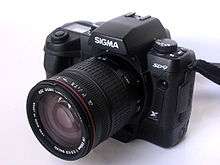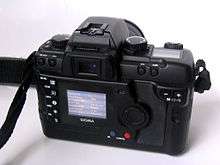Sigma SD9
 Front of the SD9 with a 28-200mm lens | |
| Overview | |
|---|---|
| Type | Digital single-lens reflex |
| Lens | |
| Lens | Interchangeable (Sigma SA mount) |
| Sensor/Medium | |
| Sensor | 20.7 mm × 13.8 mm Foveon X3 sensor |
| Maximum resolution | 2268 × 1512 × 3 (10.2 million photoelements) |
| ASA/ISO range | 100–400 in 1 EV steps |
| Storage | CompactFlash(CF) (Type I or Type II) and Microdrive(MD) |
| Focusing | |
| Focus modes | One-shot, Continuous, Manual |
| Focus areas | 1 point |
| Exposure/Metering | |
| Exposure modes | Programmed, shutter-priority, aperture priority, manual |
| Exposure metering | TTL, full aperture, zones |
| Metering modes | 8-segment evaluative, center area (about 7.5%), Center-weighted average |
| Flash | |
| Flash | none, sync at 1/180 second |
| Shutter | |
| Shutter | electronic focal-plane |
| Shutter speed range | 30 s to 1/6000 s |
| Continuous shooting | up to 2.5 frames per second |
| Viewfinder | |
| Viewfinder | Optical, pentaprism |
| Image Processing | |
| Custom WB | 6 presets, auto, and custom |
| General | |
| Rear LCD monitor | 1.8-inch (45 mm), 130,000 pixels |
| Battery | 4xAA NiMH or 2xCR-V3 |
| Weight | 785 g (body only) |

The Sigma SD9 is a digital SLR camera produced by the Sigma Corporation of Japan. The camera was launched at the Photo Marketing Association Annual Show on February 18, 2002. It was Sigma's first digital camera, and was the first production camera to use the unique Foveon X3 image sensor, which reads full color at each pixel site. Other sensors detect only one color at each site and interpolate to produce a full-color image.
The SD9 had two separate power systems; one set of CR-123A lithium batteries in the handgrip powered the camera functions, while another pair of CR-V3 batteries or four AA size rechargeables in a battery tray in the base powered the digital functions. This split power system showed that the camera functions (inherited from Sigma's SA-9 film SLR) were not integrated at all with the digital half.
Another unusual feature of the SD9 was its "dust cover" filter right behind the lens mount, to prevent dust getting into the chamber and onto the sensor when changing lenses.[1]
Reviewers and users reported good results in good lighting, but poorer ones in low light using either high ISO sensitivity or longer exposures.
The SD9 was succeeded by an updated model, the SD10, which addressed the power and low-light issues.
Software
Sigma Photo Pro
Postprozessing of RAW X3F and JPEG of all digital SIGMA cameras
Version 6.x is free Download for Windows 7+ und Mac OS ab Version 10.7 (6.3.x). Actual Version is 6.4.1 (MacOSX 10.8+, Win 7+). [2]
References
- ↑ "Sigma SD9 – Page 5: Optics". Imaging Resource. 11/09/2002. Check date values in:
|date=(help) - ↑ http://www.sigma-global.com/en/download/cameras/sigma-photo-pro/
External links
| Wikimedia Commons has media related to Sigma SD9. |
- Review at dpreview.com.
- Sigma USA page on the SD9.
- SD9 user image galleries
- SD 9 CNET specs
- SD 9 Manual PDF
| Sigma Digital Cameras | ||||||||||||||||||||||||||||||||||||||||||||||||||||||||||||||||||||||||||||||||||||||||||||||||||||||||||||||||||||||||||||||||||||||||||||||||||||||||||||||||||||||||||||||||||||||||||||||||||||||||||||||||||||||||||||||||||||||||||||||||||||||||||||||||||||
|---|---|---|---|---|---|---|---|---|---|---|---|---|---|---|---|---|---|---|---|---|---|---|---|---|---|---|---|---|---|---|---|---|---|---|---|---|---|---|---|---|---|---|---|---|---|---|---|---|---|---|---|---|---|---|---|---|---|---|---|---|---|---|---|---|---|---|---|---|---|---|---|---|---|---|---|---|---|---|---|---|---|---|---|---|---|---|---|---|---|---|---|---|---|---|---|---|---|---|---|---|---|---|---|---|---|---|---|---|---|---|---|---|---|---|---|---|---|---|---|---|---|---|---|---|---|---|---|---|---|---|---|---|---|---|---|---|---|---|---|---|---|---|---|---|---|---|---|---|---|---|---|---|---|---|---|---|---|---|---|---|---|---|---|---|---|---|---|---|---|---|---|---|---|---|---|---|---|---|---|---|---|---|---|---|---|---|---|---|---|---|---|---|---|---|---|---|---|---|---|---|---|---|---|---|---|---|---|---|---|---|---|---|---|---|---|---|---|---|---|---|---|---|---|---|---|---|---|---|---|---|---|---|---|---|---|---|---|---|---|---|---|---|---|---|---|---|---|---|---|---|---|---|---|---|---|---|---|---|---|---|
| ||||||||||||||||||||||||||||||||||||||||||||||||||||||||||||||||||||||||||||||||||||||||||||||||||||||||||||||||||||||||||||||||||||||||||||||||||||||||||||||||||||||||||||||||||||||||||||||||||||||||||||||||||||||||||||||||||||||||||||||||||||||||||||||||||||
| Sigma Digital SLR timeline | ||||||||||||||||||||||||||||||||||||||||||||||||||||||||||||||||||||||||||||||||||||||||||||||||||||||||||||||||||||||||||||||||||||||||||||
|---|---|---|---|---|---|---|---|---|---|---|---|---|---|---|---|---|---|---|---|---|---|---|---|---|---|---|---|---|---|---|---|---|---|---|---|---|---|---|---|---|---|---|---|---|---|---|---|---|---|---|---|---|---|---|---|---|---|---|---|---|---|---|---|---|---|---|---|---|---|---|---|---|---|---|---|---|---|---|---|---|---|---|---|---|---|---|---|---|---|---|---|---|---|---|---|---|---|---|---|---|---|---|---|---|---|---|---|---|---|---|---|---|---|---|---|---|---|---|---|---|---|---|---|---|---|---|---|---|---|---|---|---|---|---|---|---|---|---|---|---|
| ||||||||||||||||||||||||||||||||||||||||||||||||||||||||||||||||||||||||||||||||||||||||||||||||||||||||||||||||||||||||||||||||||||||||||||